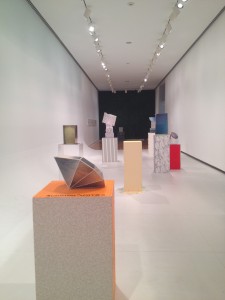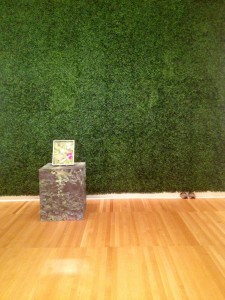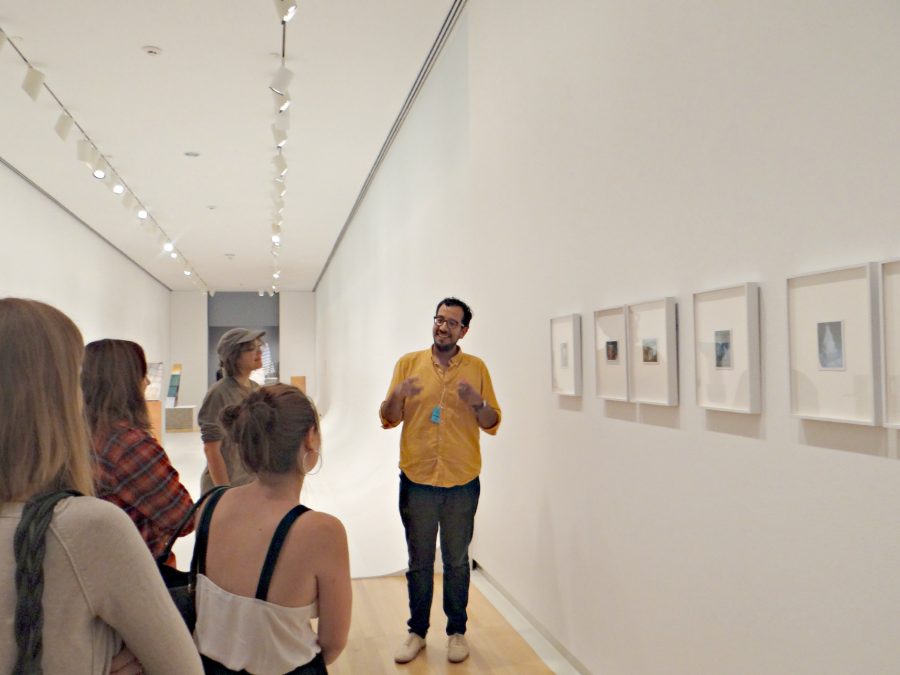If you take a trip to the Carnegie Museum of Art in Oakland, chances are you will notice a prominently displayed sign outside of Gallery One that features a name familiar to Chatham University and its students. Corey Escoto, a Chatham professor for the past five years, currently has an ongoing solo exhibition in the CMOA as a part of the 2014 Pittsburgh Biennial.
His exhibition is titled “Corey Escoto: Sleight of Hand,” and features his ‘experimental polaroids’ paired with sculptures that work alongside the photos. The polaroid images themselves, 16 in total hanging on the walls, feature different images pieced together in geometric forms instead of the standard solitary image that is conventionally associated with instant polaroid photos and photography.
These altered images play on our willingness to accept photographs as a concrete representation of truth and the world around us, when in fact they too can be so easily manipulated. They also play along with the ideas of chance, mistake and experimentation, which is in fact a part of how they came to be.

After dealing with the difficulties associated with lost digital photo files, a stolen computer, as well as a lost phone, Escoto decided to try polaroids as his photography medium.
With a large quantity of the instant film, Escoto says that with the polaroids, ” I could take pictures of anything and everything and not feel too fearful about not making great photos.” They provided a chance to have more freedom with experimenting beyond the conventional and straightforward uses of the polaroids. The new medium brought with it the freedom to experiment and make mistakes.
The polaroids in the exhibition were produced by selectively covering areas of the light sensitive film with cut stencils to control the light exposure. This is how his camera stencil method came to be, and he has been fine-tuning and experimenting with the process for nearly three years.
The camera stencil technique that Escoto uses allows for the film to go through multiple exposures instead of the usual single exposure and provides them with a look that appears to almost to have been created and manipulated in Photoshop. This creates geometric forms within the larger images that unite fragmented smaller images of different places or objects.

The various images and moments are flattened into a single pattern in one planar surface. By using this technique of multiple exposures, the instant nature of the polaroid photos is undermined, as the end product now requires more than one exposure to be finalized, but it also creates new potential for what can come of their use.
In the exhibit at the CMOA, the polaroids are accompanied by related sculptures that bring the geometric shapes and patterns of the images into three-dimensional space.

Working against the flatness of the photographs that they are modeled after, the sculptures focus on surface and are made from materials that resemble natural materials, but are exclusively synthetic and man-made. They are made from goods such as wallpaper, paint rollers, printed vinyl, spray foam, cardboard, plastic, contact paper, and Plexiglas.
This is not the first major exhibition that Escoto has been a featured part of. Last spring, he had a solo show at Taymour Grahne Gallery in Manhattan and the year prior to that he had a solo show in Brooklyn.
The show in Brooklyn, presented at Regina Rex, a small and out of the way artist run space, was able to create other opportunities for Escoto, including his current show at the Carnegie.
He says, “each show is important, even the small ones, and I try to produce the best possible outcome given the situation for every show, big or small.” This just goes to prove that every show that an artist puts their work into is important, regardless of size, as they can lead to greater opportunities in the future.
“Corey Escoto: Sleight of Hand” is on display in Gallery One of the Carnegie Museum of Art through September 29, 2014.


